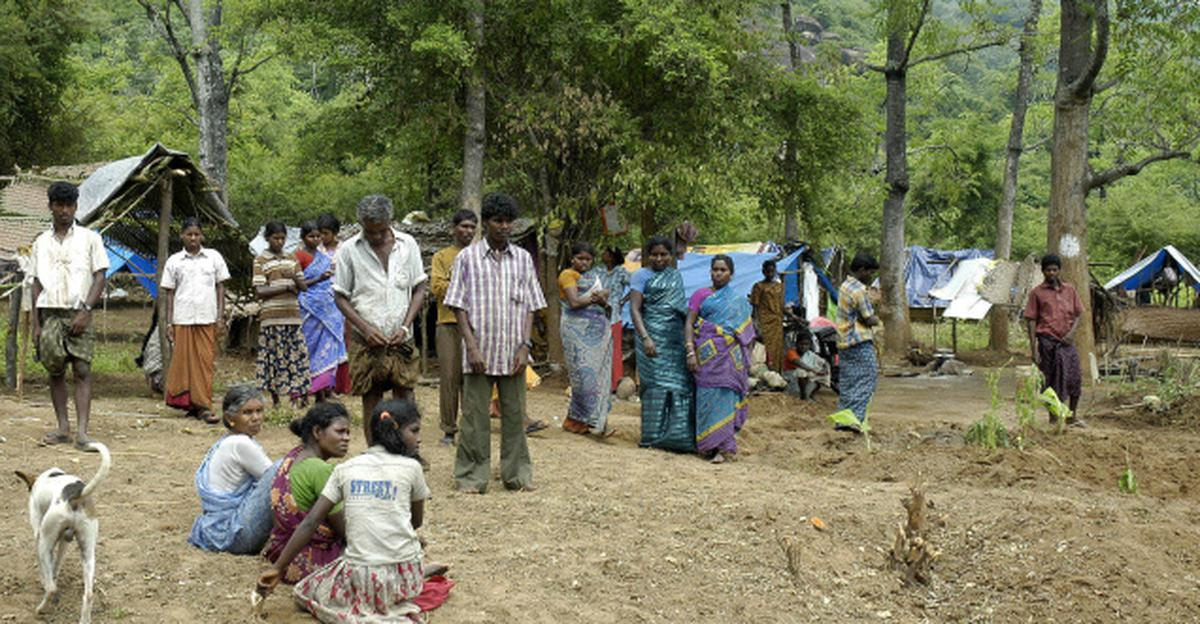Description

Copyright infringement not intended
Picture Courtesy: https://www.thehindu.com/news/cities/Madurai/28-Paliyar-tribal-families-intensify-fight-for-land-titles/article15690313.ece
Context: The recent research findings highlight the urgent need for immediate government action to address the socio-economic challenges faced by the Paliyar and other tribes.
Details
- The recent research findings on the Paliyar and other tribes in the Kodaikanal and Theni areas in Tamil Nadu highlight the urgent need for action from local organizations and community members to address the socio-economic challenges faced by these communities.
Key points from the research
- Despite the presence of 1,173 families across 36 villages, not a single individual from these communities has secured a government job. This point to significant barriers such as poverty, illiteracy, and lack of opportunities.
- The research highlighted the need for immediate and comprehensive efforts by the State government to uplift Paliyar tribes and other marginalized Adivasi communities.
- Individuals from these communities have voiced concerns about inadequate basic facilities in their villages and have called on the government to address their grievances promptly.
Proposed Actions
- Creating specific plans and timelines for promoting and developing livelihoods among indigenous and marginalized populations in Tamil Nadu.
- Allocating dedicated funds for implementing targeted schemes and initiatives.
- Establishing a separate government department and appointing a cabinet minister to oversee tribal welfare.
- Collaboration with voluntary organizations and civil societies to utilize support and resources.
|
This research emphasizes the critical need for immediate and sustained government intervention to improve the lives and opportunities for Paliyar tribes and other marginalized groups in Tamil Nadu.
|
About Paliyan Tribe
- The Paliyan people, also known as Palaiyar or Pazhaiyar, are a Dravidian tribal group living in the South Western Ghats montane rain forests of South India, mainly in Tamil Nadu and Kerala.
Traditional Lifestyle and Economic Transition
- The Paliyan tribe historically relied on hunting, gathering, and foraging for their sustenance, with yams being a major food source. In the early 20th century, they dressed scantily and lived in rock crevices and caves.
- Over time, many Paliyans have transitioned to trading forest products, cultivating food, and beekeeping. Some also work as wage labourers on plantations, reflecting economic changes and adaptation to modern livelihood practices.
- They are traditionally nomadic hunter-gatherers and foragers. They rely on activities such as hunting small game, fishing, and collecting honey. Yams are a major food source for them.
- They practice shifting cultivation, where they cultivate small plots of land for a few seasons before moving on to new areas to allow the land to regenerate.
|
Yams are starchy staples in the form of large tubers produced by various species of the Dioscorea genus, which includes both wild and domesticated varieties. They are cultivated in regions across Africa, the Americas, the Caribbean, the South Pacific, and Asia.
|

Cultural Identity and Language
- The Paliyans speak a Dravidian language closely related to Tamil, emphasizing their cultural heritage and regional ties.
- The society is patriarchal, with men holding positions of authority. However, women also play a significant role in daily life and decision-making within the household.
- They worship nature spirits and deities residing in the forests, mountains, and rivers. They also offer prayers to Vanadevadai, a deity associated with the forest, and worship Karuppan, a deity in local folk traditions. These rituals often involve visits to remote forest areas with their families.
- Traditionally, they do not burn bodies. Instead, they have customary burial practices where the deceased are buried in designated areas near their residential settlements, commonly on the western side.
- They are known for their beautiful and intricate bamboo basketry. They also excel in making mats, bows and arrows, and other items from natural materials.
|
Tribal herbal practitioners play a crucial role in providing healthcare using traditional botanical preparations among the Paliyar tribes.
|
Social, Economic, and Environmental Issues
- Historical and contemporary accounts document the forced displacement of Paliyan communities from their traditional lands, leading to social and economic hardships.
- The Paliyan, dependent on forest resources for livelihood, face challenges due to deforestation, poaching, and degradation of natural habitats.
- Paliyan communities rely on traditional botanical preparations and herbal medicines for health care, treating various ailments common in their environment.
Way Forward
- Organizations and activists advocate for the rights and welfare of Paliyan communities, highlighting government neglect and the need for sustainable development practices.
- Efforts are made to preserve Paliyan cultural traditions, language, and knowledge systems, including ethnomedicinal practices and ecological wisdom.
Source:
The Hindu
Wikipedia
|
PRACTICE QUESTION
Q. Consider the following statements in the context of the Paliyar tribes:
1. They primarily reside in Andhra Pradesh and Telangana.
2. They are traditionally nomadic hunter-gatherers.
3. Yams are a major food source for the Paliyar tribes.
4. They speak a Dravidian language closely related to Telugu.
How many of the above statements are correct?
A) Only one
B) Only two
C) Only three
D) All four
Answer: B
|
Array
(
[0] => daily-current-affairs/paliyar-tribes
[1] => daily-current-affairs
[2] => paliyar-tribes
)














